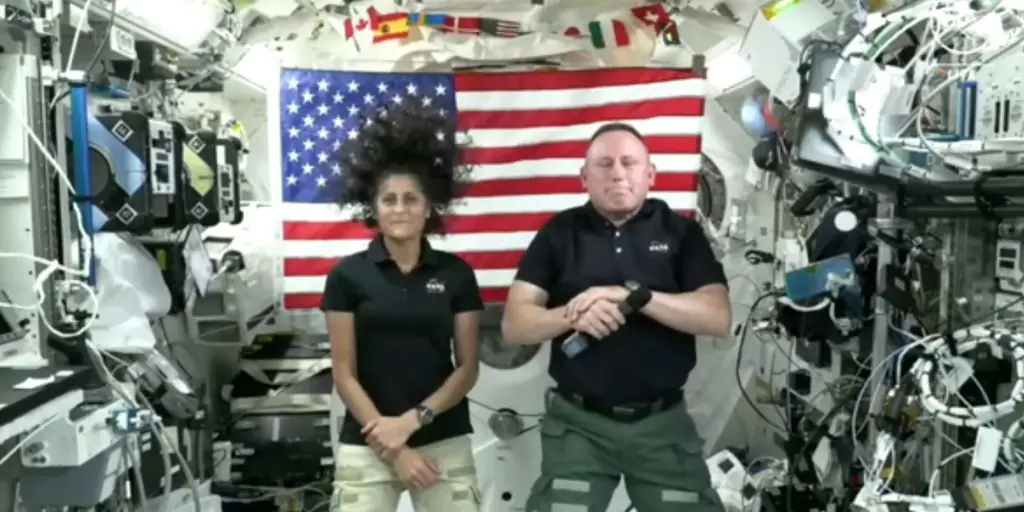“He was losing momentum and we didn’t know why.”

They were stuck on the International Space Station (ISS) for a month longer than expected and still have no return date. NASA astronauts Suni Williams and Butch Wilmore are still “stuck” in the orbiting lab after arriving … there, they first tested the Boeing Starliner with a crew, which was problematic almost from the start. Now, both have spoken from space about how they encountered a moment when their ship stopped responding correctly just before docking with the ISS, forcing them to make two attempts.
“The launch was spectacular, truly spectacular,” Wilmore said during an online press conference the astronauts held with reporters Wednesday. “We were amazed at the precision that the ship maintained until day two,” he continued. But then, as the crew piloted the spacecraft toward the ISS, problems arose: One of the 28 thrusters in Starliner’s reaction control system (RCS) suddenly shut down. Then another one stopped working.
“We noticed that the thrust, the control, the power were all down. The handling wasn’t right,” continued his partner Williams, a U.S. Army test pilot like Wilmore. “But at the time, we didn’t know why.” That’s why they aborted the first attempt to make all the necessary checks.
The astronauts abandoned their first attempt to dock the spacecraft to the ISS and took over manual control for more than an hour while teams on the ground tried to troubleshoot the problems. However, up to five boosters unexpectedly shut down during the process. The astronauts and crew managed to restore some of them, although the situation was still suboptimal.
Still, they headed to dock the spacecraft at the orbiting lab, this time in automated mode: “The Starliner came down right in the middle, even with the engines failing, which was really impressive given what we know now,” Wilmore said. Finally, the craft managed to safely deliver the astronauts to the ISS, where they have remained ever since.
Previous issues
In fact, the troubles began even before liftoff. After years of delays, Starliner was finally assembled on the Kennedy Space Center launch pad at Cape Canaveral, with the intention of lifting off with a crew on board on May 6. However, two hours before the expected ascent was to begin, it was called off due to a malfunction in the Atlas V rocket’s oxygen release valve. While investigating that problem, a second one was discovered: a helium leak, this time in the craft, delaying liftoff by a month.
Finally, on June 6, Starliner was lifted out of Florida and headed to the ISS. But from the start, it presented new problems: since entering low-Earth orbit, the crew detected two more helium leaks. Then the crew experienced the aforementioned engine failure.
Since then, the astronauts have been conducting various tests of Starliner, although both Boeing and NASA have assured that the ship is “stable and ready to leave the ISS in an emergency,” as the leaks have stabilized and it can land without damage to the engines and that the astronauts are “not stuck.” However, in addition to the tests in space, those responsible for the probe will conduct a new campaign of tests on the ground, in particular at the White Sands Test Site in New Mexico, to replicate the use of the engines during flight and be able to understand what is happening.
“These tests are unpredictable in terms of how long they will take and what we will find in them,” Nappi said in a media appearance a week ago, though the tests are estimated to take about two weeks, requiring more analysis later. And that’s why neither NASA nor Boeing has set a return date for Starliner at this point.
Boeing’s delicate situation
NASA has required Boeing to put Starliner through extensive testing to find out what happened. In fact, the ship, which has always encountered failures in all its tests in space, has already been found to have up to five helium leaks: the first, uncrewed and carried out in 2019, never reached its destination (ISS); the second, also uncrewed, in 2022, recorded problems with the ship docking to the space station and during re-entry with a parachute and wiring.
This crewed mission with Williams and Wilmore is expected to be the final test to certify the spacecraft for regular astronaut missions and for Starliner to become NASA’s “space taxi” to the ISS, as SpaceX’s Crew Dragon Starliner has been doing since 2020.
The fuel leaks and failures are the latest in a series of problems Boeing has encountered with its spacecraft over the years, putting it far behind rival Elon Musk’s company. It’s unclear how the new problems will impact Boeing’s ability to get its spacecraft into regular orbit around the space station. Still, Wilmore and Williams are confident: “We’re very excited about the opportunity to put more people on the spacecraft once we get back and work on all the issues we’ve already found,” Williams said.
